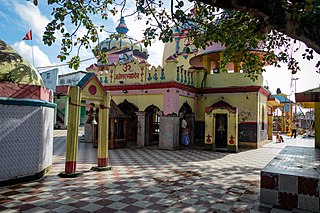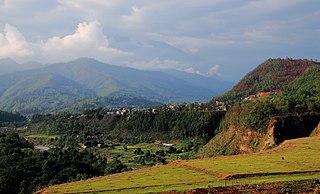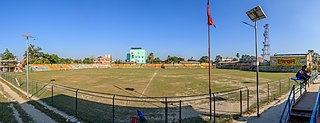Related Research Articles

Mahendra Bir Bikram Shah Dev, was the ninth King of Nepal from 13 March 1955 until his death in 1972, which was due to heart attack as told in an interview by his personal physician Dr. Mrigendra Raj Pandey. Following the 1960 coup d'état, he established the partyless Panchayat system which governed the country for 28 years until the introduction of multiparty democracy in 1990. During his reign, Nepal experienced a period of industrial, political and economic change which opened it to the rest of the world for the first time after the 104-year-long reign of the Rana rulers, who kept the country under an isolationist policy, came to an end in 1951.

Birendra Bir Bikram Shah Dev, was the tenth King of Nepal from 1972 until his assassination in 2001. He was the eldest son of King Mahendra.

Mechi was one of the fourteen zones of Nepal until the restructuring of zones to provinces, comprising four districts; namely Ilam, Jhapa, Panchthar and Taplejung. Its headquarters are at Ilam. It comes under the Eastern Development Region of Nepal. The Indian state of Bihar is to the south, West Bengal and Sikkim in the east and Tibet to the north. The largest town is Damak in the Terai. The majority of the population in Mechi are Limbu, Chettri, Bharmin, Maithil and Meche.

Mahottari District, a part of Madhesh Province, is one of the seventy-seven districts of Nepal. The district, with Jaleshwar as its district headquarter, covers an area of 1,002 km2 (387 sq mi) and had a population of 553,481 in 2001, 627,580 in 2011 and 705,838 in 2021 census. Its headquarters is located in Jaleshwar, a neighbouring town of the historical city of Janakpur. The name Jaleshwar means the 'God in Water'. One can find a famous temple of Lord Shiva in Water there. Jaleshwar lies at a few kilometres distance from the Nepal-India border and has a majority Maithili population.

Nawalparasi District, part of which belongs to Gandaki Province and part to Lumbini Province, was one of the 75 districts of Nepal before being divided into Parasi District and Nawalpur District in 2015.

Nuwakot District, a part of Bagmati Province, is one of the seventy-seven districts of Nepal. The district, with Bidur as its district headquarters, covers an area of 1,121 km2 (433 sq mi) and had a population of 288,478 in 2001 and 277,471 in 2011.

Ratna Rajya Lakshmi Devi Shah is a member of the Nepalese royal family who was queen consort of Nepal from 1955 to 1972 and queen dowager from 1972 to 2008 when the royal family were stripped of all titles and privileges. She is the second wife of King Mahendra (1920–1972). Ratna belongs to the aristocratic Rana family and is the daughter of Field Marshal Hari Shamsher Jang Bahadur Rana and his wife, Megha Kumari Rajya Lakshmi.

Mahendra Highway, also called East-West Highway, runs across the Terai geographical region of Nepal, from Mechinagar in the east to Bhim Datta in the west, cutting across the entire width of the country. It is the longest highway in Nepal and was constructed in cooperation with various countries. The highway is named after King Mahendra Shah.

The Narayanhiti Palace Museum is a public museum in Kathmandu, Nepal located east of the Kaiser Mahal and next to Thamel. The museum was created in 2008 from the complex of the former Narayanhiti Palace following the 2006 revolution. Before the revolution, the palace was the residence and principal workplace of the monarch of the Kingdom of Nepal, and hosted occasions of state.
Mahendra Adarsha is a town and Village Development Committee in Bara District in the Narayani Zone of south-eastern Nepal. At the time of the 1991 Nepal census it had a population of 3,563 persons living in 655 individual households. The municipality is named after late king Mahendra.
Lalmatiya is a town and Village Development Committee in Dang District in Lumbini Province of south-western Nepal. At the time of the 1991 Nepal census it had a population of 12,048 persons living in 1900 individual households.
Bhiman is a town in Kamalamai Municipality Ward no. 11 in Sindhuli District in the Janakpur Zone of south-eastern Nepal. At the time of the 1991 Nepal census it had a population of 7,609 people living in 1,389 individual households.

Hanuman Dhoka is a complex of structures with the Royal Palace of the Malla kings and also of the Shah dynasty in the Durbar Square of central Kathmandu, Nepal.The Hanuman Dhoka Palace gets its name from the stone image of Hanuman, the Hindu deity, that sits near the main entryway. 'Dhoka' means door or gate in Nepali. The buildings were severely damaged in the 2015 earthquake.
The Dundwa Range is a subrange of the Sivalik Hills in western Nepal and northern Uttar Pradesh, India. It separates the Outer Terai of Balarampur and Shravasti districts in Uttar Pradesh from Deukhuri Valley in Nepal's Dang-Deukhuri and eastern Banke districts. The international border follows the southern edge of this range, leaving a zone of forested Bhabar inside Uttar Pradesh.

Ratna Park is a park and surrounding district in central Kathmandu, Nepal. It is named after Queen Ratna, the wife of King Mahendra. It was built for the children and is named after Ratna, the second queen of King Mahendra. It is situated between Rani Pokhari and Tudikhel in the heart of Kathmandu.
The first golf course in Nepal was the Gauchar Golf Course, in Gaucharan, established by General Kiran Shumsher in 1917, after observing the sport in Scotland. This first course was in Nepal 'browns', i.e. greens consisted of sand mixed with oil. King Tribhuvan Shah and his son Prince Basundhara Shah also played golf.

Sahid Rangasala is a multi-purpose stadium in Biratnagar, Koshi Province, Nepal. It has a capacity of 15,000 spectators. It was renovated for hosting the SAFF Women's Championship in 2019. The stadium is home to Morang XI and Biratnagar City F.C.

Gandaki Province ), is one of the seven federal provinces established by the current constitution of Nepal which was promulgated on 20 September 2015. Pokhara is the province's capital city. It borders the Tibet Autonomous Region in Southwest China to the north, Bagmati Province to the east, Karnali Province to the west, and Lumbini Province and Bihar of India to the south. The total area of the province is 21,504 km2 - constituting 14.57% of Nepal's total area. According to the latest census, the population of the province was 2,479,745. The newly elected Provincial Assembly adopted Gandaki Province as the permanent name by replacing its initial name Province No. 4 in July 2018. Surendra Raj Pandey is the present chief minister of Gandaki Province.
Mahendra Ratna Multiple Campus is one of the constituent campuses of Tribhuvan University in Ilam district in eastern Nepal. The campus was established in Asar 21, 2017 BS. The campus is also approved by University Grants Commission of Nepal. The campus was named after the then-ruling monarch King Mahendra and his wife Queen Ratna.
References
- ↑ Museums and art galleries of Nepal (Archived August 19, 2012, at the Wayback Machine )
- ↑ "Mahendra Museum, Nepal". Nepal.com. Retrieved 2022-08-02.
27°42′16″N85°18′26″E / 27.70436°N 85.30721°E